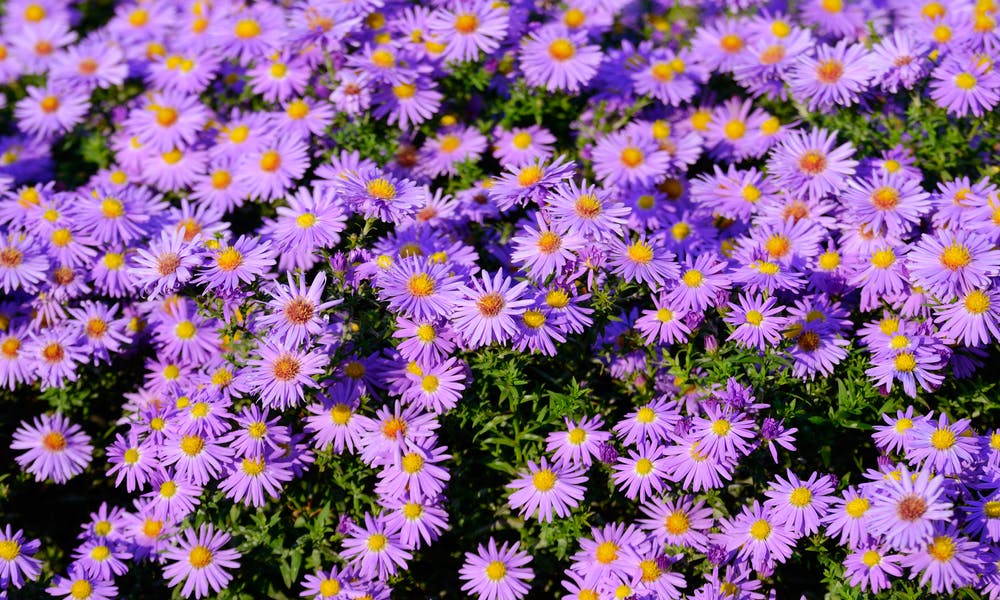MENU
Aster Flower: The Star of the Ground

If you find yourself looking for a diverse flower to suit every occasion, the Aster flower may be for you. Aster’s are daisy-like wildflowers known for the unique star-shaped flower head. Most of these flowers are found to have a yellow center, surrounded by a vibrant, yet soft mix of cool and warm colors. Aster flowers have also earned a few nicknames along the journey through time, such as Starworts, Frost Flowers, and Michaelmas Daisies. These wildflowers are typically found in North America; although, some species have originated in South America, Europe, and Asia. Considering they are wildflowers; they are also cutting flowers. Florists from around the world still use them from late summer to early winter to create some impeccable arrangements. To dig deeper, the story lies within the flower.
Here are some of the interesting topics you can expect to obtain from this article. There is so much more to a flower than people suppose.
- Definite History
- History of Flower as Symbols
- Significance
- Aster Uses
Every single part of this flower has a true significance, from the roots to the edge of the petal.
Definite History
The Aster flower has a passionate kind of history, one to pull you into the existence of nature. The word “aster,” itself, comes from a rich background in Greek mythology. It is believed the Greek goddess Astraea had such grace within her soul, that her tears are what brought this flower it’s presence. Astraea was a lover of the night, admiring the cooler colors of the sky, she noticed how different the colors came to be. The lack of a bright sky made her weep. Her weeping led to so many emotions from within, asters began to bloom.
As Astraea began to admire the flowers that had bloomed, they were as poised with beauty and grace as she was. She decided to name them “aster,” referencing the stars she wished to see in the sky. Not only were the Greeks fans of this wildflower, but also the Victorians. Thomas Jefferson, himself, was a major fan of one genus of the Aster, the China aster.
History of Asters as Symbols
As spoken in the paragraph above, Victorians were known for using floriography. Floriography is coded communication by the exchange of flowers, which was used extensively with asters. Asters come in a wide range of colors from white to a splashing blue. Knowingly the most common of the asters, the deep purple so vibrant, represented wisdom and royalty. As anyone could assume, pink is typically associated with love; as red bestowed to dedication and devotion. When thinking of white, typically imagine a clean slate and that is just what white was symbolized with, purity and new beginnings. Even though this method of communication is rarely used, the symbols with these flowers live on with their roots.
Due to the annual and perennial varieties of the aster, it is found the connotation with this flower in September. They are officially the flower for September birthdays and 20th wedding anniversaries. The calming color of the lavender pastel aster can set the perfect mood for loving occasions. Aster’s have such a deep history, and the English and French often use them in coffee shops, as well as boutiques to connect with their customers and engage in personal conversation.
It is also believed in parts of Asia that burning asters with small fires can ward off serpents. Acclaimed poet, Robert Frost, is known for his devotional passion for nature. In the well-known poem, “A Late Walk,” he paints an image of admiration to a dull scene, brightened with the blue of a hazy aster.
Aster Uses
Asters have multiple uses from the past to the present and in and out of the garden. Native Americans believed the aster had powerful uses for all kinds of everyday complications from swelling to open wounds, to fevers and aiding indigestion.
In the present day, nature experts inform doctors of the uses; considering, numerous patients are trying to be organic with medications. Asters for medication can be broken down with a mortar and pestle to form a powder-like substance for creams or can be capsuled to take orally. The flower can also be taken orally by being broken down into a tea; this is most commonly used to aid the digestion. Asters have prebiotics they naturally draw from their roots to the base of the stem. Furthermore, in the garden, aster can be used as a colorful barrier around the edges to protect overgrowth from within. Simply, they can also be used as a catching display for everyone to see the beauty in nature.
Summary
Unlike roses and lilies, asters are not as appreciated through their blooming season. Asters have such an alluring history, the stories behind it paint a vivid picture in every mind it touches. The prosperity in Greek mythology truly inspires the mind to trace the past with the significance this flower encounters.
These flowers are not only wonderful to look at, but also were used in communication in the Victorian ages. Considering, this communication is not used very often anymore, maybe it can soon arise again to praise the white asters new beginnings and purity.
To this day, asters are often found being used in Europe in coffee shops and boutiques to engage customers in conversation. The rich history allows for customers to ask questions about the flower, workers then bless them with the knowledge leading up to the petals of today. Likewise, Asters possess the ability to have multiple uses. Native Americans used these flowers for all kinds of healing aspects. The people of today find these flowers as a wonderful barrier to protect and outline their gardens, protecting each other flower inside.

